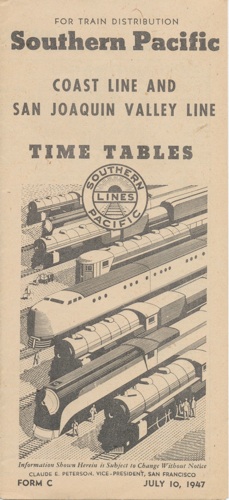Service Aboard the Daylight

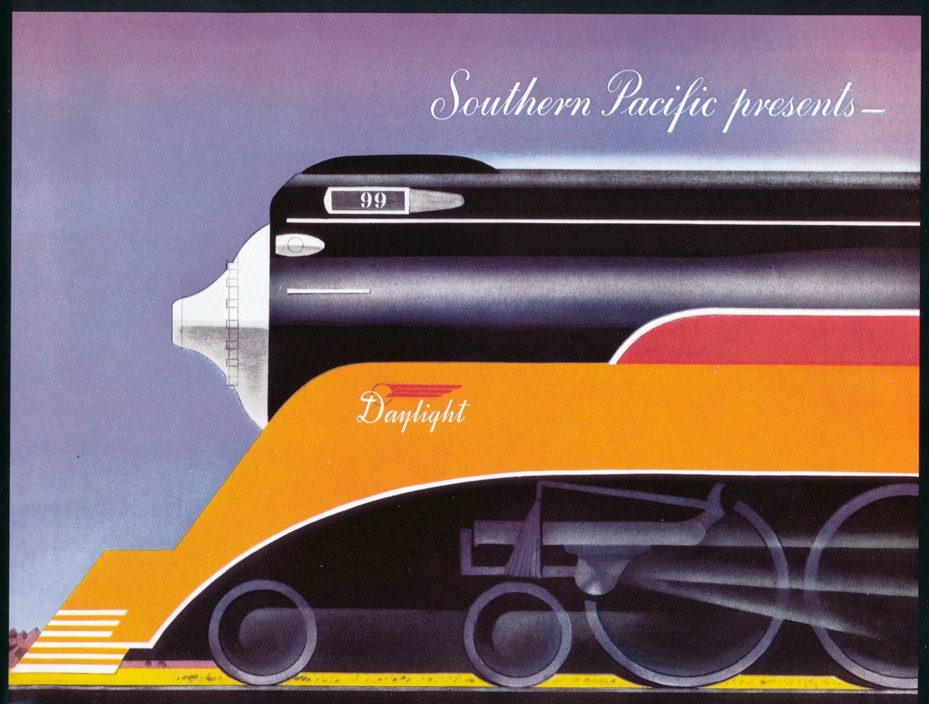
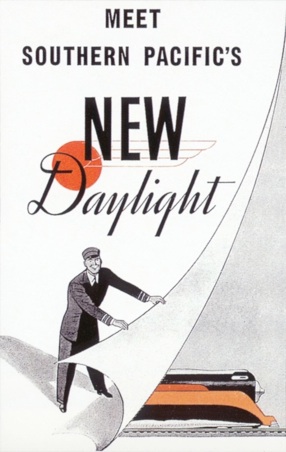
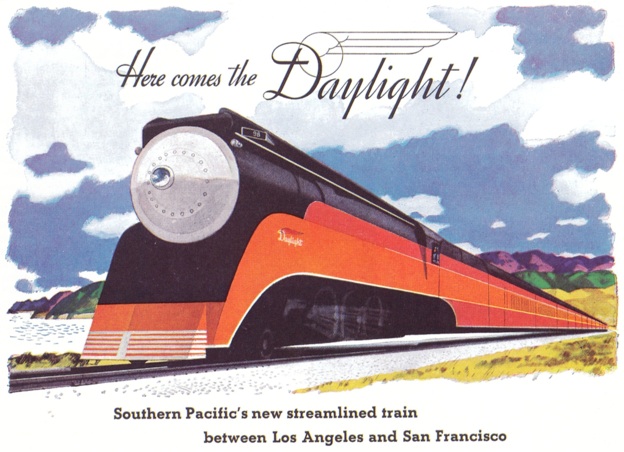
Let us stand by the tracks of Southern Pacific's Coast Line, as thousands now do every day, and listen ... North and South the shining steel stretches along the shore. There is no sound but the soft murmur of the surf. Suddenly from far off comes a musical note, rising. Round a curve flashes a streak of color. Here comes the Daylight, the most beautiful train in the West!
Southern Pacific's streamlined Daylight is the West's newest and finest train, linking Los Angeles and San Francisco in a glorious daylight trip, streaking along the edge of the Pacific Ocean for more than a hundred breathless miles. Two identical trains give daily service in each direction. Costing $1,000,000 each, custom built from stem to stern, they are pulled by the largest, most powerful streamlined locomotives in the world.
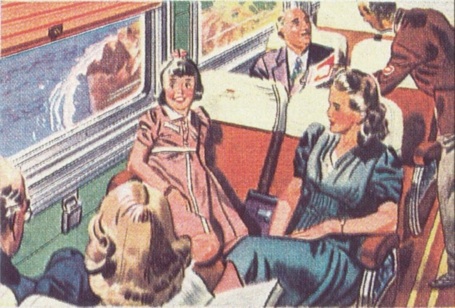
Step inside the Daylight and see the beauty and luxury that have already won the West. Notice the wide, soft seats in the coaches. They are cushioned with sponge rubber and turn to face the extra ordinarily large windows. Each seat has an individual light and recessed ash tray. Note how the color scheme changes in every car, and how harmonious and restful the colors are - smoke gray, Nantes blue, French green, apricot, tan.
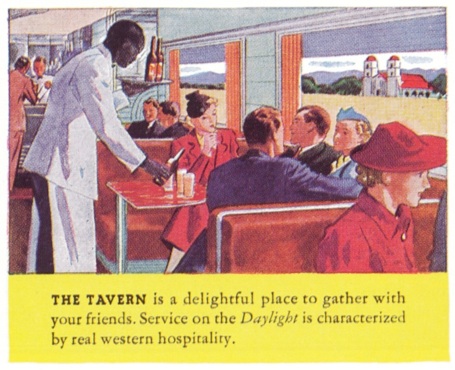
Here is the tavern with its big, deep semi-circular leather lounges. The tavern bar on the Daylight tells an eloquent story of the pleasures that await you. Relax with a tall, cool glass and watch some of the grandest scenery in the world unroll before you.
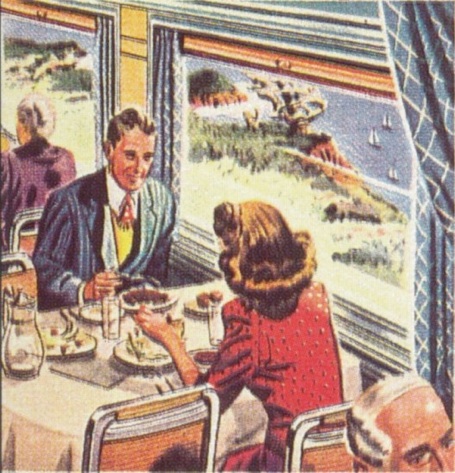
Now, the diner. Observe the cheerful colors and the bright flowers on the tables. Notice that tableware and linen bear the winged Daylight emblem. All of it was especially designed for this train. There is also a separate coffee shop, thus giving you a choice of menu and price to meet your every mood and appetite.
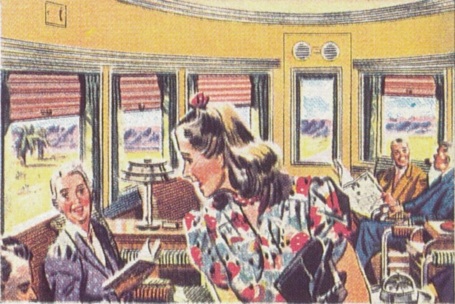
Finally, the parlor car, with its supremely comfortable chairs, and the parlor observation car that ends the train in a smooth, windowed curve.
The Daylight is, of course, completely air-conditioned. There is radio reception in every car except the diner. First class, tourist and couch tickets are all honored on the train. (Parlor cars are restricted to first class tickets, plus a nominal seat charge.)


To ride on "The Most Beautiful Train in the World", you needed to purchase a ticket in advanced. All seats on the train, including chair cars and parlor cars, were reserved. You had to reserve and purchase a ticket by mail, telegraph, telephone, or in person at the Los Angeles or San Francisco "Chart Room". When reserving a ticket, you had to make sure to tell them if the party traveling was male or female and if you wanted an ocean or land side seat. Tickets could be reserved by telegraph or telephone, but no space was held longer than noon before the date of departure and must be purchased at the ticket office in person and not on the train.
Before the Daylights started operating in 1937, Southern Pacific pushed out a massive advertisement campaign about their new train. With colorful graphics and descriptive text, their ad department was really good at making you want to ride this new fantastic train!

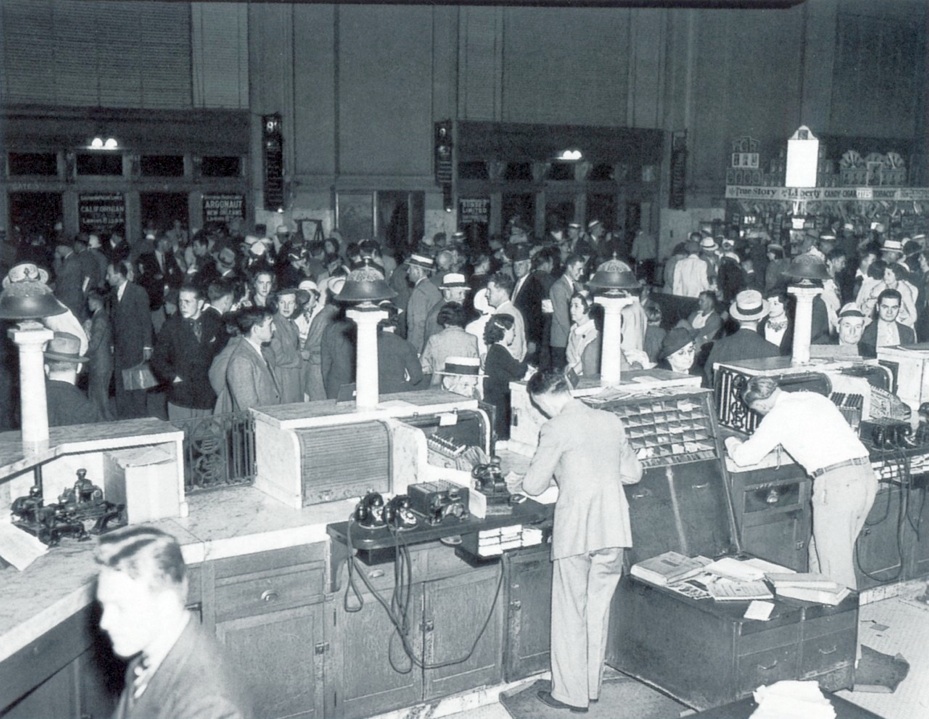
Of course, you could try your luck at the ticket counter for a last minute ticket! This view is of the ticket counter in Los Angeles.
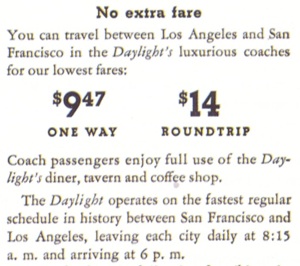
1937 Daylight fares were $9.47 one way or $14 roundtrip between Los Angeles and San Francisco in the streamlined chair cars. Chair car passengers had full access to the Coffee Shop, Diner, and Tavern cars. The two Parlor cars were restricted to first class passengers. First class fares were $14.20 one way or $18.75 roundtrip plus a seat charge of $1.50 each way. If a boarding passenger holding a roundtrip coach ticket wanted to upgrade to a parlor car seat, their ticket could be raised to first class (by the Conductor or Passenger Agent) for $4.73. Each passenger occupying a seat in the drawing room on the Parlor car was charged a one seat fare. If the room was desired for exclusive occupancy, the minimum of three seat fares and two rail tickets was required.
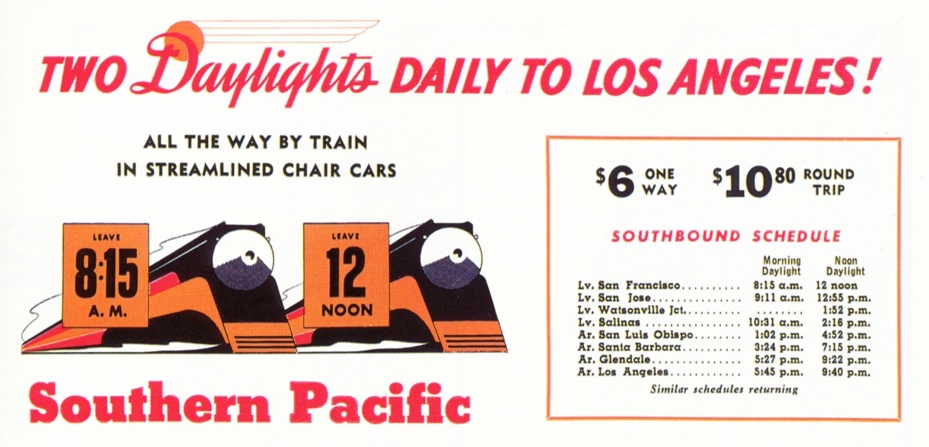
In 1938, Southern Pacific's competitor, Santa Fe, had introduced a highly competitive $5.15 one way fare or $9.30 roundtrip between San Francisco and Los Angeles. After 18 months of running the first Daylight passenger train, Southern Pacific was forced to lower its one way fare to $6 or $10.80 roundtrip. First class Parlor car seats were slashed to $10.50 one way or $15.40 roundtrip (no seat charge). To put these prices in perspective, the average hourly depression era wage was around a dollar. As a side note, fares for the Daylight would not return to pre-competitive levels until 1952.
Before buying your ticket, you would want to take a look at the current Southern Pacific Time Tables to plan your trip. This particular time table was dated July 10, 1947.
Click on the time table to view the contents inside.

Once you received your ticket, usually by mail, you had some time to plan your trip. The ticket shown above was issued by SP on September 11, 1944 for a departure date of October 8, 1944. More than likely this person mailed in their request and payment at the beginning of September for their planned trip more than a month away.

Your ticket specified what car number you were on and what seat number. The graphic above depicts the 16 car Morning Daylight consist on June 18, 1941. The revenue seat cars were: CB (Chair-Baggage), ACW (Articulated-Chair Women's Restroom), ACM (Articulated-Chair Men's Restroom), C (Chair), PR (Parlor), and PRO (Parlor-Observation). Seats next to the isle were odd numbered seats while the even numbered seats were along the windows. Facing the engine, if you were riding train 98 from San Francisco, the ocean side seats would be the seats on the right of the isle. Train 99 from Los Angeles would have ocean side seats on the left of the isle. The other cars in the consist were the triple unit diner car CS (Coffee Shop), K (Kitchen), and D (Diner), and single car T (Tavern). Porters (P) manned the locations next to the car vestibules to help you on/off the train and load/unload luggage.
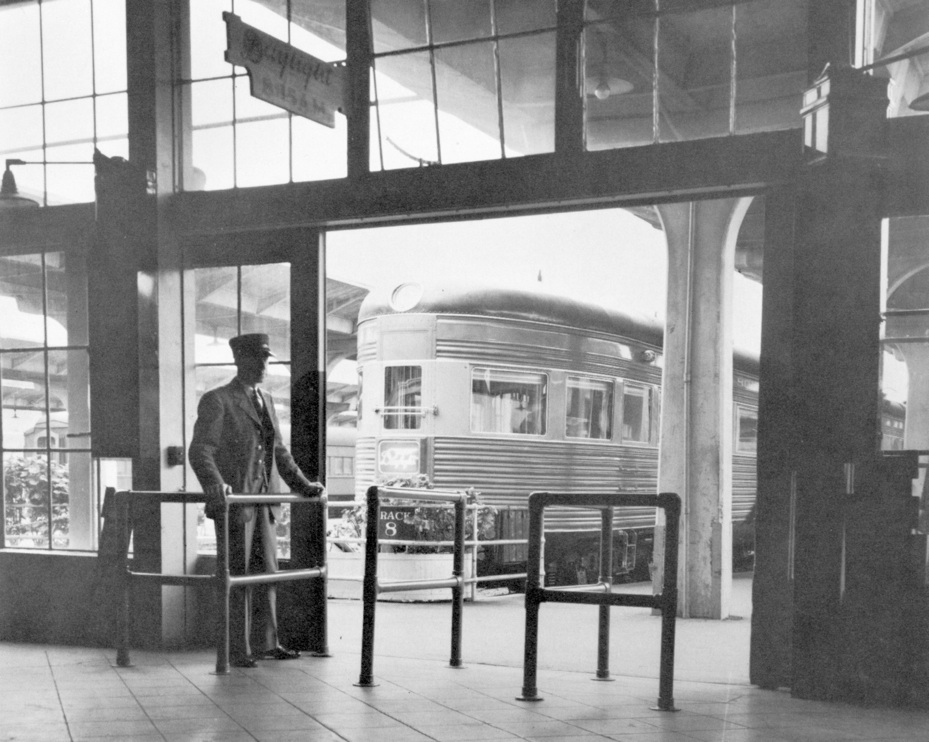
When passengers walked into the train station for a morning's ride on the Daylight, they were greeted by a cheerful Station Agent at the loading gate. Reaching the gate they would get their first glimpse of the Daylight sitting at the track with her stunning color scheme. They were in for an amazing journey with all the comforts of home. This particular view is at Southern Pacific's mission style train depot in San Francisco.
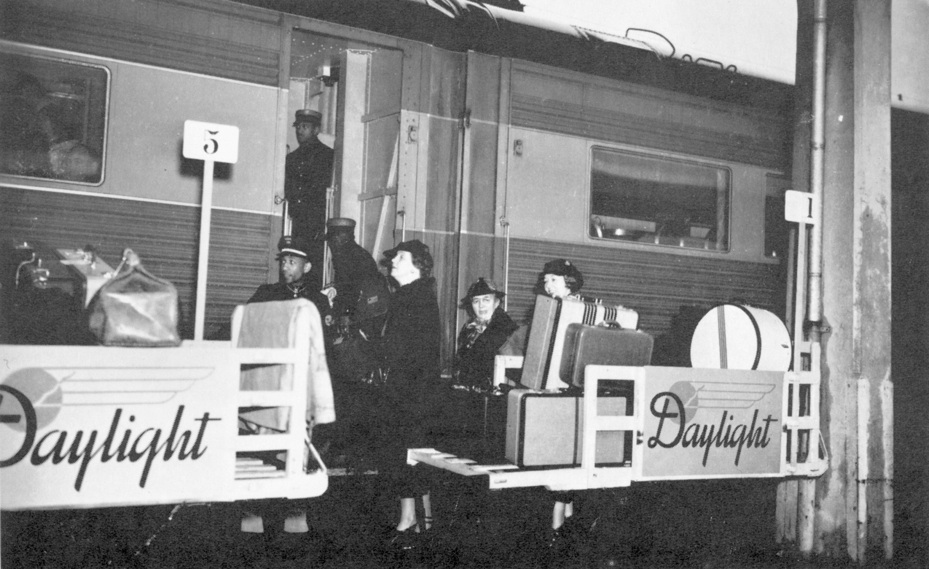
As you entered the platform, a cheerful "Red Cap" greeted you, checked your ticket, then placed your luggage into a pre-assigned baggage cart. Passengers could then walk and board the train without the burden of carrying their luggage. This was first class service! Note the carts had sign boards noting what car they were associated with. Porters were at their positions to help you on the train and handle the luggage.
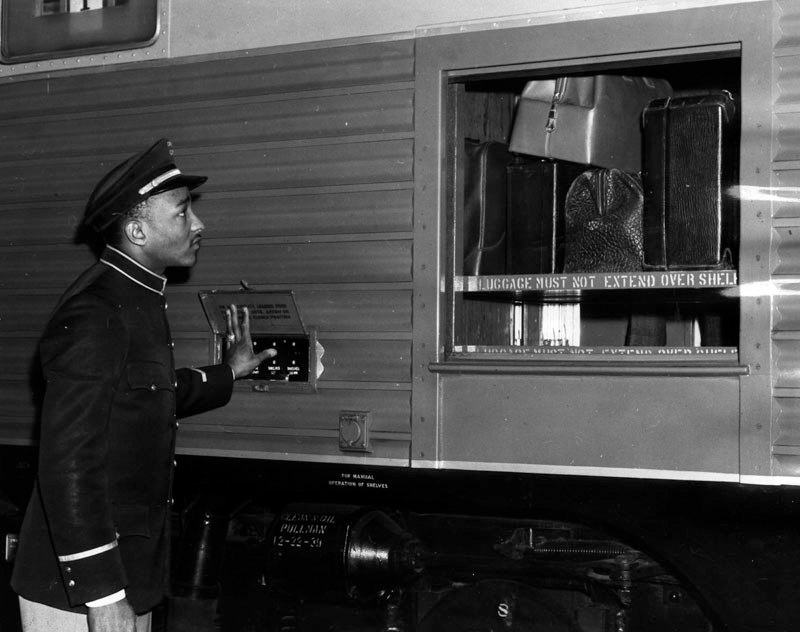
Here you see one of the Porters operating the Baggage Elevator. This was an SP invention for the new 1939 and 1941 passenger cars. After a shelf was loaded, the Porter would push a button for the shelf to rise up, exposing the next shelf to load up with baggage.
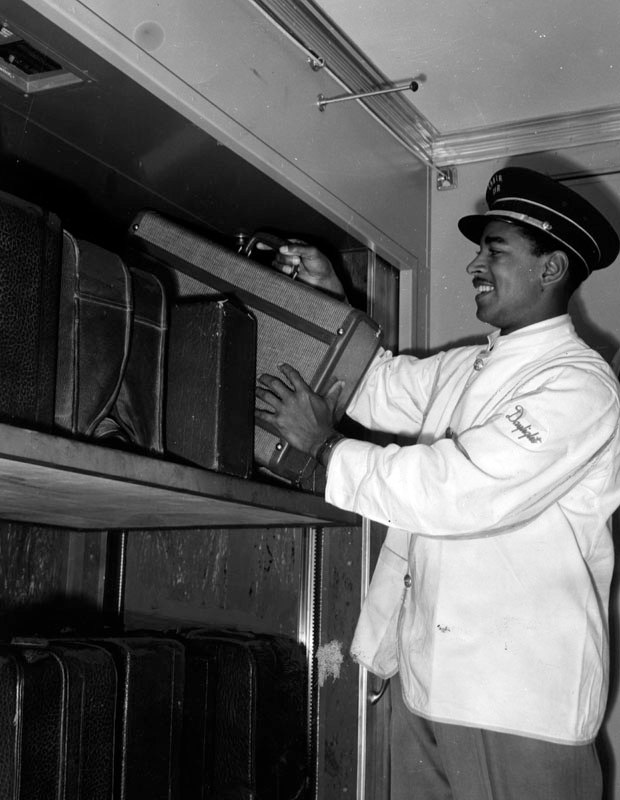
On the other side of the Baggage Elevator inside the car, the Porter could re-adjust the baggage for safe travel or retrieve a passenger's baggage if needed.


Once you found your seat on the train, you probably wanted to try out your chair, swivel it, recline it, and check out your large window. The passenger cars were wide and spacious with full insulation and air-conditioning. Double-glazed five foot picture windows gave passengers a grand view of the scenery as they sat in aircraft type contour seats that reclined and rotated. Interior decor was both pleasing and restful, and a radio in every car provided an informative commentary. Interior wall colors alternated between cars from green, blue, yellow, and apricot. Ceilings were ivory white.
Note the hats lined up on the upper rack. Everything is so nice and neat. These photos were taken by Southern Pacific for promotional purposes.

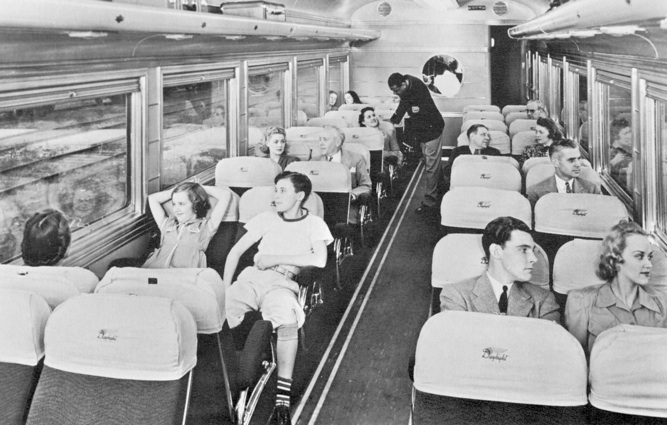
Families could swivel their chairs to face each other or to keep an eye on the kids. Everyone could recline, relax, and enjoy the view.
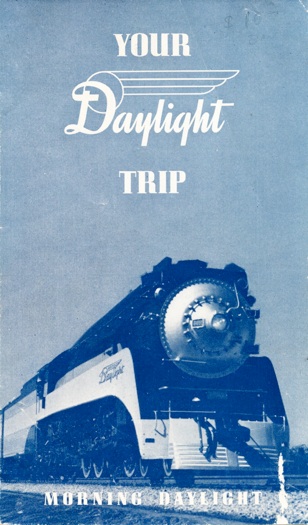
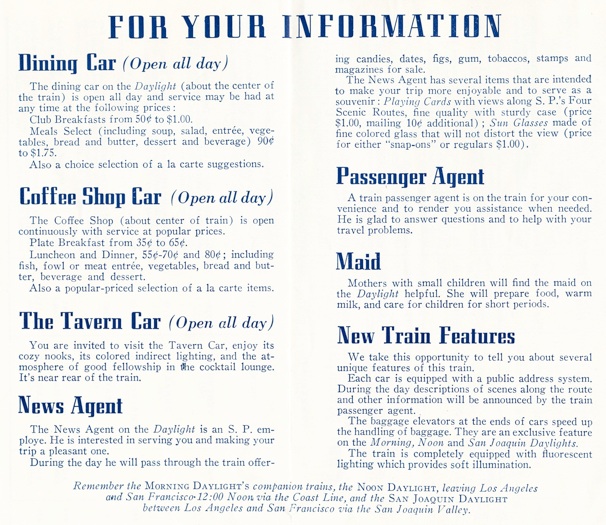
When you sat down you found a little brochure titled "Your Daylight Trip". Daylight passengers could learn about their journey which featured a stylized map and information about places of interest along the route. It also included information about the Dining car, Coffee Shop car, Tavern car, News Agent, Passenger Agent, the Maid, and the new train's features.

Southern Pacific Coast Daylight Trip
Use this interactive map to explore the Coast Daylight route between Los Angeles and San Francisco. The route and location information came from the brochure that was passed out to the passengers.
Navigating the interactive map:
Click on the double arrows >> to display the Legend and Details tabs. Click on the tabs to display their information. Click on the double arrows << to close Legend/Details tabs.
You can zoom in and out using the + and - buttons or use your mouse scroll wheel. You can also double click to zoom in on a point.
You can pan around by clicking on the map and dragging it around with your mouse.
To return the map to the initial view, click the home button.
Click on one of the orange circle symbols on the route to display a popup menu about the city or location. You can zoom into the city or location by clicking on the zoom icon at the bottom of the popup. Click on the x to close the popup.
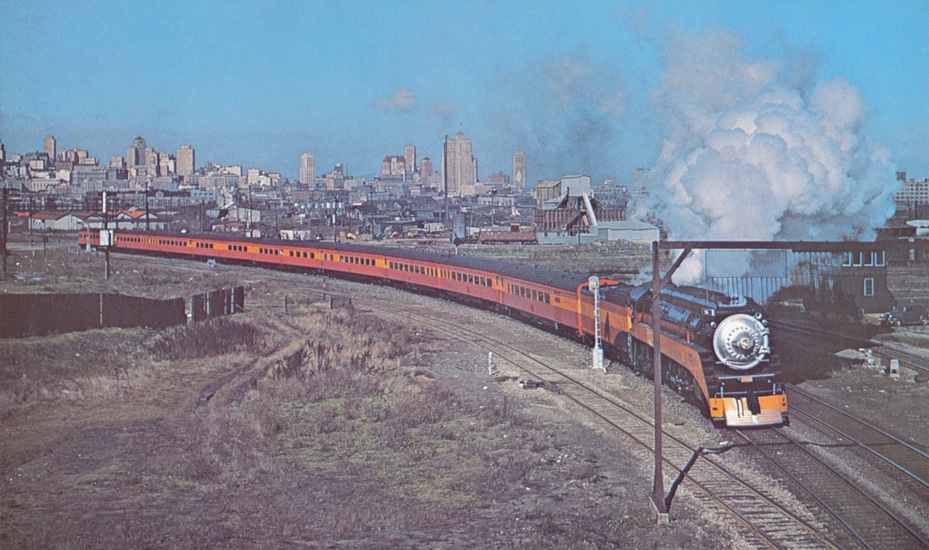
Promptly at 8:15 a.m. both trains departed, one in Los Angeles heading North and the other in San Francisco heading South. Bells ringing and air horns blowing, both engines steamed out of their terminals heading for the other's starting point.

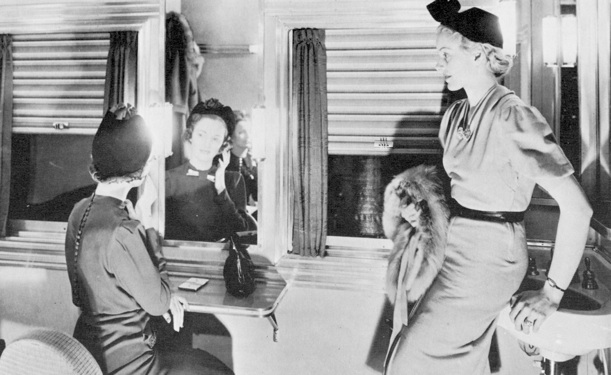
On the Daylight the toilet facilities were modern in every way, with the best available plumbing and chrome-plated piping. Air tanks underneath the car forced hot and cold water to the double wash basins. Furnished with upholstered chairs and sofas, portieres and floor coverings, the ladies' lounges and men's smoking sections were so roomy that some Daylight passengers went there just to relax. If you were a lady, you could freshen up in the ladies' lounge. The ladies' lounge was designed for comfort and convenience with a vanity table and smoking chairs. Women aboard the Daylight could always look their best.
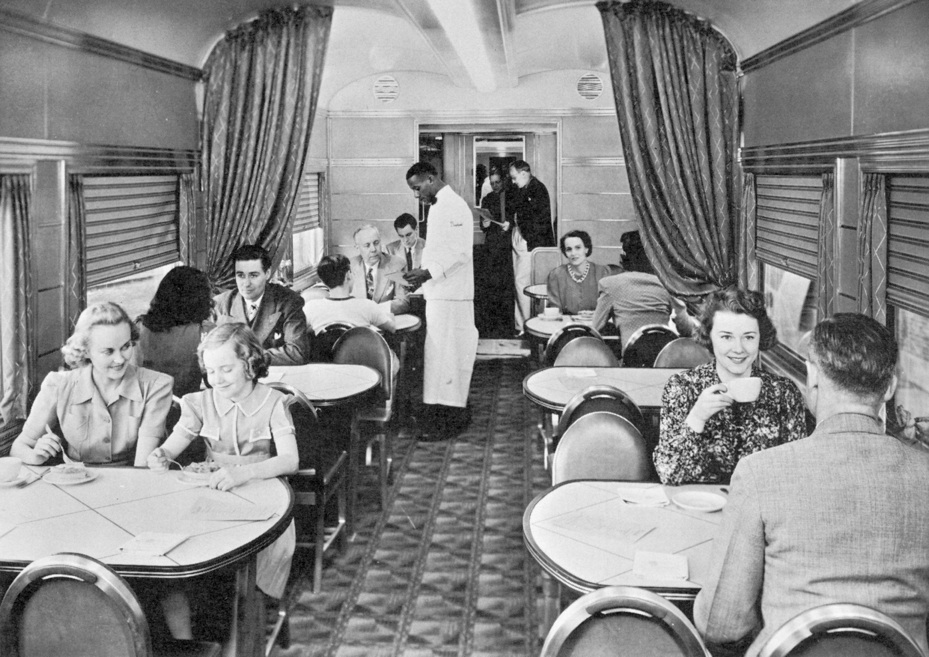
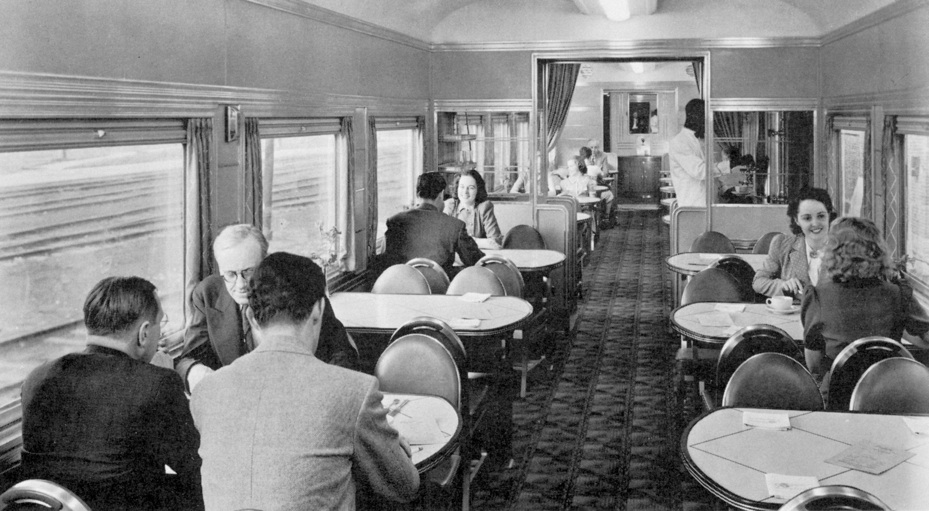
Should you get hungry for a quick bite, you could head on over to the Coffee Shop car. Part of the triple unit diner, the Coffee Shop car was plush, with carpets, drapes, and curtains. It had a very homey atmosphere. Passengers could eat and enjoy the passing scenery through the extra large windows.
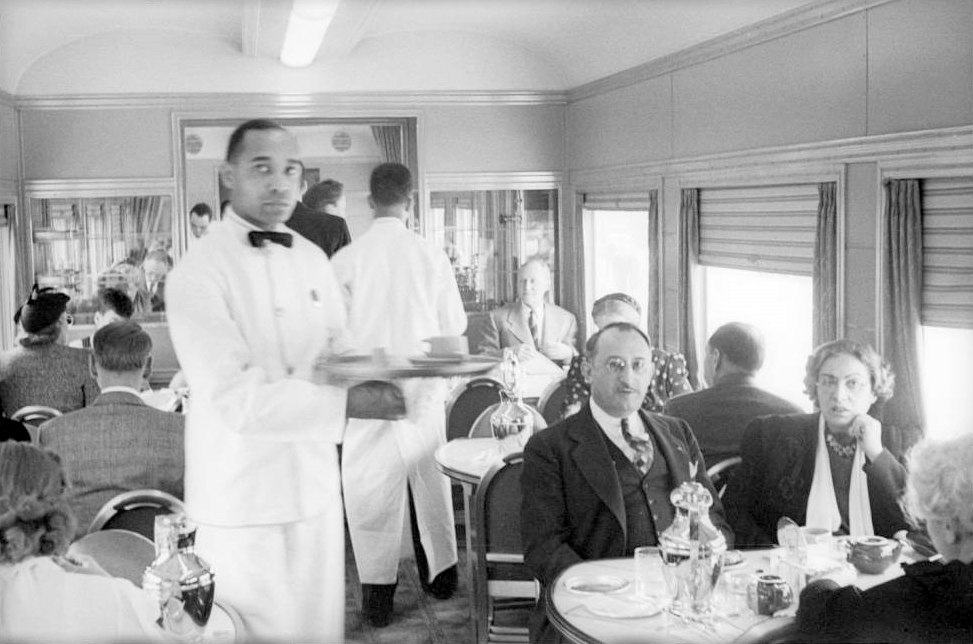

The black and white photo above was not taken by Southern Pacific, it was a candid shot taken by a passenger, so nothing staged here. Passengers really did dressed up to ride the train. Also note the rare color photo of the Coffee Shop and wait staff. The wall color in this car is yellow with an ivory ceiling and chrome accents. Also note the silver service on each table. It looks so formal and this is just the Coffee Shop. All passengers on the Daylight traveled in style!
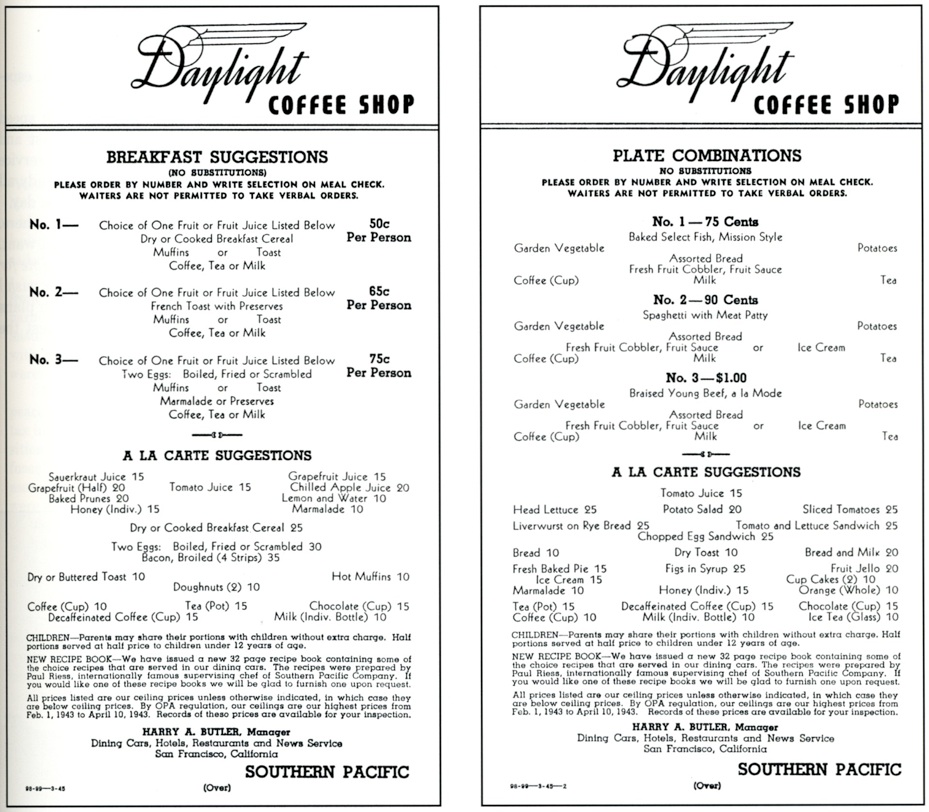
Above are Coffee Shop menus with 1945 prices. Breakfast No. 3 for 75 cents is a deal!


For formal dining, the Daylight's Dining car was the place you wanted to be. Here dining was first class! The Diner served the finest meals in the shortest time and at prices one could afford. Breakfast 25 to 45 cents, and lunch and dinner 35 to 65 cents with a choice of fish, meat, or fowl plus a vegetable, bread and butter, beverage, and dessert. Passengers would no sooner order than the waiter began serving their meal with a pleasant smile. Food prices on the Daylight remained at the 1937 level until the mid-40s.
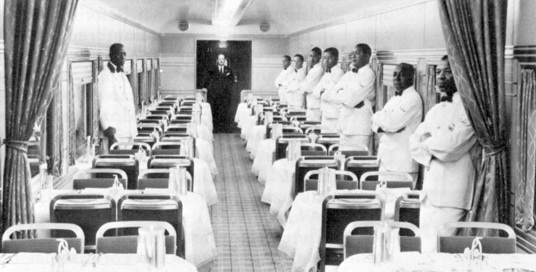

The meals and service were hard to beat. The Daylight had the record for meals served aboard a long distance train. More than 12 million passengers wined and dined! SP properly dressed the Dining car with snappy looking wait staff, table linen, and custom top-marked silver service all bearing the Daylight herald.
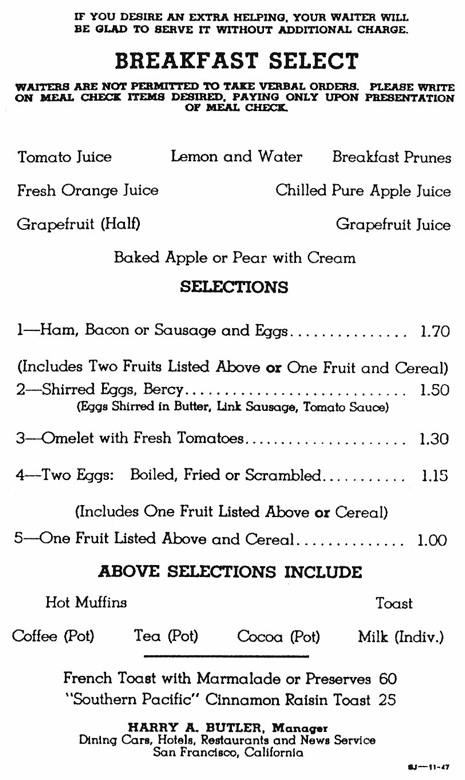
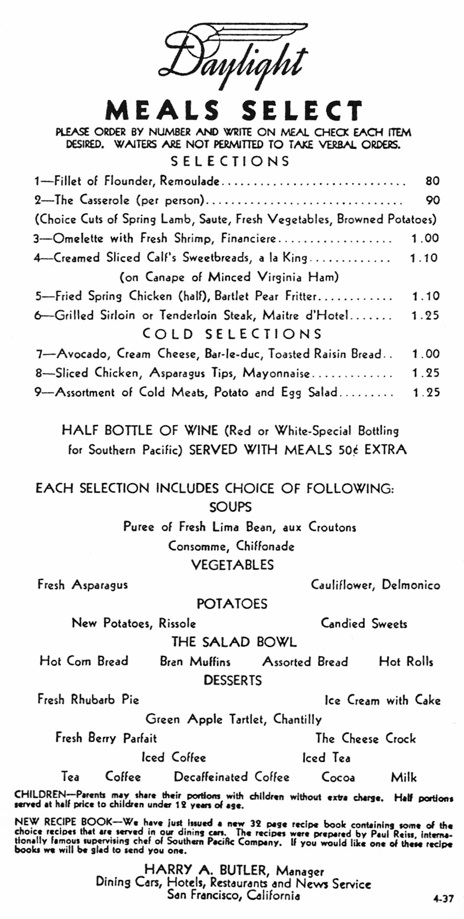
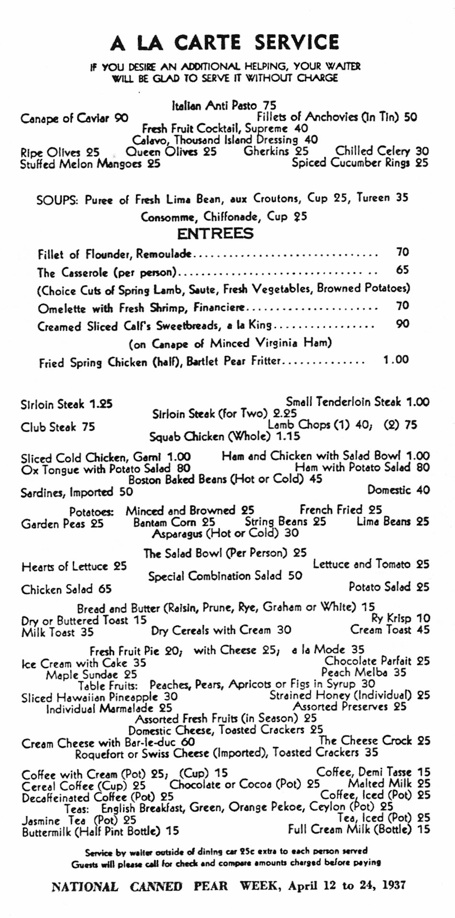
SP was famous for their Menu Select meals. Gentlemen in coats and ties and ladies in suits and hats would partake in the formal Breakfast Select menu (1947 menu shown left) and Meals Select menu (1937 luncheon menus shown above). As evidenced by the Coast Daylight's luncheon menu, passengers had a selection of no less than nine hot and cold entrees, plus an array of specialities served a la carte.
You could enjoy fresh caught brook trout and prime steaks and chops as well as SP's famous Salad Bowl. Note that if one desired an additional helping, your waiter would be glad to serve it without charge! No restaurant or diner could match the luxury, comfort, or prices of the triple unit dining car.
Staff in the Kitchen car were always busy preparing meals for passengers in the Coffee Shop and Dining cars.
One of the experiences of riding on the Daylight was the announcements made by the Train Passenger Agent who kept you well informed of the train’s progress and points of interest along the 471 mile trip. This was accomplished over the Daylight’s public address system with the aid of a script prepared by Southern Pacific. For Train 99, from Los Angeles to San Francisco, the script was entitled “Script for Coast Daylight, Train 99” and was read during the trip this way:
Announcement No. 1, To be made immediately upon leaving Los Angeles
“Good morning Ladies and Gentlemen. Breakfast is now being served in the coffee shop and dining cars located in the center of the train between cars 7 and 8. Thank you.”
Announcement No. 2, To be made after leaving Glendale
“Again good morning Ladies and Gentlemen. May I have your attention, please. This is Mr. (YOUR LAST NAME), your Daylight Passenger Agent speaking. We're happy to have you with us today and we know you will enjoy your trip on the Daylight. As Train Passenger Agent, I am on the train to answer any question you may have about transportation details of your trip. I will be passing through your car from time to time. First, I'd like to remind you that breakfast is being served in the coffee shop and dining cars located in the center of the train between cars 7 and 8. For your convenience, please be sure to tell your car porter how far you are going and identify your hand baggage even though you hold Red Cap Porter checks for it, in order that he may arrange to put your baggage off at the proper station. Please also check which he hands you is correct. Your particular attention is called to the small folder which has been distributed throughout the train. The northbound and southbound schedules of the Daylight are shown, also the times when the train passes points of interest along the line. The folder gives you interesting information about communities and scenic attractions, and about the facilities provided on the Daylight for your comfort. You can follow the progress of your trip today with this folder, and the information given in it will help you to make your trip more enjoyable. The News Agent will pass through the train from time to time with various items for sale. He also has a store in Car 1, the first car on the train. You are also invited to visit our Tavern car which is located as the third car from the rear of the train. Thank you!”
Announcement No. 3, To be made after passing Ventura
“Ladies and Gentlemen, for the next two hours you will enjoy what many people say is one of the most beautiful train rides in America. For many miles the Daylight runs right along the shores of the Pacific, and in some places the track is just above the rolling surf. Every mile gives you a magnificent panorama of seashore and mountains with an occasional glimpse of a lighthouse on a rocky headland. May we make a suggestion so that no one will miss this spectacular scenery. We have noticed that passengers will often pull down the window shade next to them, to avoid the direct sun, or for some other reason, and then leave it down for a long time, not realizing that they are cutting off the view of others sharing the window with them. We suggest, as a courtesy to your neighbors, that you do not keep the shades down any longer than necessary so that everyone may enjoy as much of the view as possible. Thank you!”
Announcement No. 4, To be made before arrival at Santa Barbara
“May I have your attention, please! Our next station stop will be Santa Barbara, a world famous resort city, beautifully situated between the ocean and the Santa Ynez mountains. In graceful living and in the architecture of its homes and commercial buildings, Santa Barbara retains much of the spirit of old Spanish California. From the earliest days, visitors have been drawn to Santa Barbara by its fine climate and the hospitality of its people. We will stop here for only a short time and it is important that passengers going beyond Santa Barbara remain in their seats and not leave the train. Please claim your hand baggage on the station platform as you step off the train. Thank you!”
Announcement No. 5, To be made after leaving Santa Barbara
“Ladies and Gentlemen, we will appreciate it if all passengers who boarded the train at Santa Barbara will have their tickets and seat reservation tickets out of the envelopes and ready to hand to the conductor as he passes through your car. Be sure to tell the conductor and your car porter how far you are going so that your baggage can be put off the train at the right station.” (MAKE SHORT PAUSE, THEN MAKE LUNCHEON ANNOUNCEMENT NO. 6)
Announcement No. 6, To be made at 10:45 a.m.
“May I have your attention, please! Starting at 11:30, luncheon will be served in the coffee shop and dining cars, both located in the center of the train, between cars 7 and 8.” (DINING CAR CUT-OFF ANNOUNCEMENT TO BE MADE WHEN DINING CARS ARE APPROXIMATELY THREE-QUARTERS FILLED) “Ladies and Gentlemen, all seats in the coffee shop and dining cars are
filled at the present time. Will you kindly remain in your seats for approximately 20 to 30 minutes at which time space will become available. Thank you!” (PASSENGER AGENT SHOULD STATION HIMSELF IN DINER AND WATCH THE SITUATION CLOSELY MAKING APPROPRIATE ANNOUNCEMENTS DIRECTED TO ATTENTION OF PASSENGERS IN CARS OF TRAIN SERVED BY COFFEE SHOP TELLING THEM WHEN SEATS ARE AVAILABLE AND ALSO WHEN ALL TABLES ARE OCCUPIED. THIS IS IMPORTANT)
Announcement No 7, To be made before arrival at San Luis Obispo
“May I have your attention, please! Our next station stop will be San Luis Obispo, the half-way point between Los Angeles and San Francisco. Passengers detraining at San Luis Obispo please claim your hand baggage on the station platform as you step off the train. San Luis Obispo is located in a bowl shaped valley at the base of the Santa Lucia Mountains. The city had its beginning with the founding of Mission San Luis Obispio in the year 1772. We will stop here for a very short time and I want to ask everyone going beyond San Luis Obispo please remain on the train. Thank you!”
Announcement No. 8 & 9, To be made immediately after leaving San Luis Obispo
“Ladies and Gentlemen, we will appreciate it if all passengers who boarded the train at San Luis Obispo will have their tickets and seat reservation tickets out of the envelopes and ready to hand to the conductors as they pass through your car. Please be sure to tell the conductor and your car porter how far you are going so that your baggage can be put off at the right station.” (PAUSE FOR COLLEGE ANNOUNCEMENT) “At the north city limits of San Luis Obispo we will pass thru the 2,000 acre campus and farm of California Polytechnic College for Agriculture and Industry which was established by the people of California.”
Announcement No. 10, Time of announcement variable depending upon performance of trains 98 and 99
“Ladies and Gentlemen, if you will look to your right you will see the southbound Daylight.”
Announcement No. 11, To be made before reaching San Miguel
“Ladies and Gentlemen, the route of the Daylight between Los Angeles and San Francisco follows quite closely El Camino Real, the King's Highway, the name of the original road which connected the Old Spanish Missions. The Missions were built at intervals of about 30 miles which was a day's horseback ride. There were 21 in California, extending from San Diego to Sonoma, north of San Francisco. In just a few minutes you will see to your left San Miguel Mission which was built in 1797. The taller building is the original mission. Thank you!”
Announcement No. 12, To be made before arrival at Salinas
“Ladies and Gentlemen, our next station stop will be Salinas, largest city of the Salinas Valley and transfer point for the Monterey Bay Area. The Monterey Bay Area is visited by thousands of tourists, attracted by the beaches of white sand, the resort hotels, and tournament golf courses, and the lingering flavor of the Old Spanish Days of California. Passengers going to Del Monte, Monterey, Pacific Grove, Carmel, Watsonville, Aptos, Capitola and Santa Cruz will find the motor coaches for those points waiting just behind the station. Passengers detraining at Salinas please claim your hand baggage on the station platform as you step off the train. We will stop at Salinas only long enough to detrain passengers and it is very important that everyone else remain on the train. Thank you!”
Announcement No. 13, To be made immediately after leaving Salinas
“Ladies and Gentlemen, will passengers who boarded the train at Salinas please have their tickets and seat reservation tickets out of the envelopes and ready to hand to the conductors as they pass through your car. We are now traveling through the Salinas Valley, an important agricultural and livestock region. The section around the city of Salinas, which we have just left is called the “Salad Bowl of America,” because thousands of carloads of lettuce are shipped from here each year. If you have not already done so, please tell your car porter how far you are going and identify your hand baggage, even though you hold Red Cap Porter checks for it, in order that he may arrange to put your baggage off at the proper station. Please also make sure the destination on the duplicate check which he hands you is correct. This should be done as soon as possible, otherwise your luggage may be carried through to San Francisco and turned over to the Baggage Department as unclaimed baggage. As a convenience to those passengers destined for San Jose or San Francisco, you may arrange with your car porter to check your hand baggage for delivery to you at the Yellow Taxi loading zone in front of the station. A charge of 15 cents per article is made for this service and payment is made to Station Red Cap Porter. Passengers enroute to points in the East Bay including Oakland Pier, First and Broadway Station, Fruitvale, San Leandro or Hayward; or to points on the Peninsula between San Jose and San Francisco may arrange with their car porters to have their hand baggage checked through to their destination and such baggage will be transferred to their connecting transportation at San Jose. Passengers who hold orange baggage checks and who are remaining in San Jose may claim their baggage in the station by Gates 3 and 4. Thank you!”
Announcement No. 14, To be made before arrival San Jose
“May I have your attention, please! Our next station stop is San Jose. First, may I ask that anyone planning to detrain at San Jose who has not at some time during the day been contacted by their porter, kindly inform the porter of your present plans. This is in order that he may get your baggage off at San Jose. Will all passengers allow the porters in their cars to remove hats, coats and packages from the racks above your heads. Passengers destined to points in Oakland which include Oakland Pier, First and Broadway Station and Fruitvale Station will find their connecting train (No. 255) on track next to the Daylight. Passengers destined to points on the Peninsula between San Jose and San Francisco should go into the station for your connecting train No. 151. Passengers holding orange baggage checks and who are planning to remain in San Jose will identify and claim their baggage in the station by Gates 3 and 4. All passengers not detraining at San Jose are requested to remain on the train, we stop only long enough to detrain and entrain passengers. Our next station stop is San Jose. Thank you!”
Announcement No. 15, To be made before arriving San Francisco
“Ladies and Gentlemen, our next station stop will be San Francisco. Passengers holding white baggage checks with green stripe or yellow baggage checks will find their baggage at the Yellow Taxi loading zone in the station. This is Mr. (YOUR LAST NAME), your train Passenger Agent speaking. I want to say now for myself and for the conductor and for every Southern Pacific employee on the train that we have been happy to have you with us today. We hope that your trip has been a pleasant one. Some of you may not know that Southern Pacific has other streamlined trains between San Francisco and Los Angeles. Our San Joaquin Daylights take you through the great San Joaquin Valley and over the Tehachapi Mountains by daylight. The streamlined Starlights run overnight between San Francisco and Los Angeles on the Coast Route. The low Daylight coach fares apply on both the Starlights and the San Joaquin Daylights. Our luxurious all-Pullman night trains, the Larks, also run between San Francisco and Los Angeles on the Coast Route. We also have streamlined Shasta Daylights between San Francisco and Portland, over the scenic Shasta Route, at low coach fares. Southern Pacific appreciates your patronage and we hope you will use our service many times in the future. Thank you!”
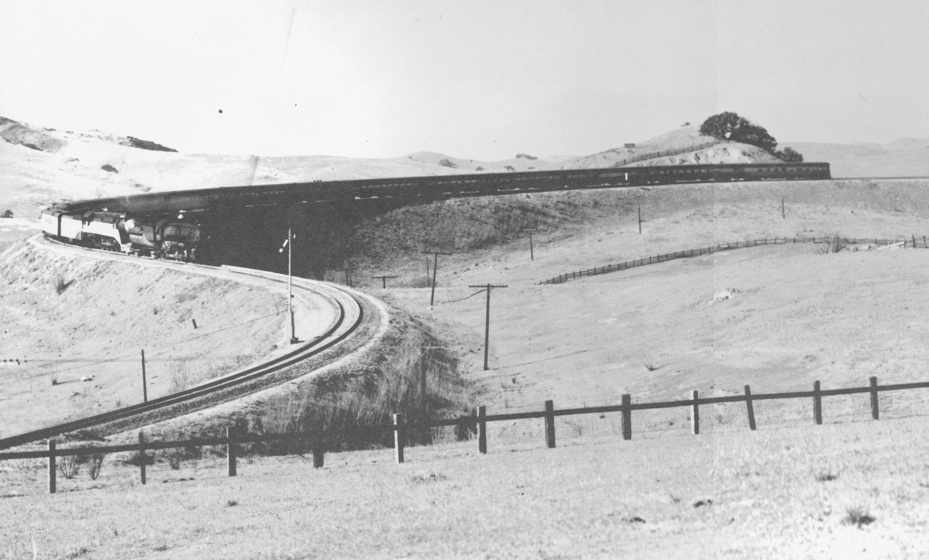
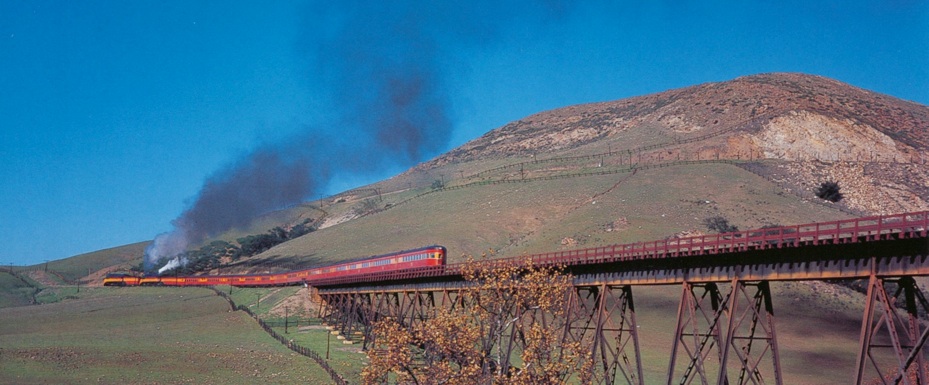

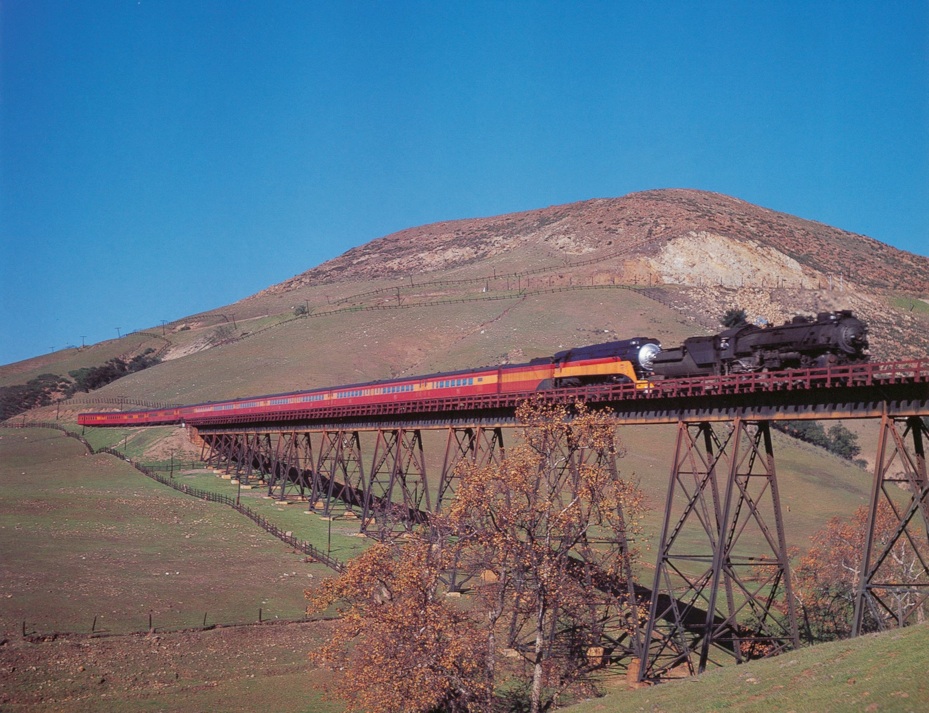
Scenic highlights of the Coast Line included the 16.5 mile Cuesta Pass between Santa Margarita and San Luis Obispo. Here is where the train negotiated seven tunnels, one bridge, and tight reverse curves (53 curves in all) as it descended (going South) or ascended (going North) the famous Goldtree horseshoe curve at a 2.2% grade.
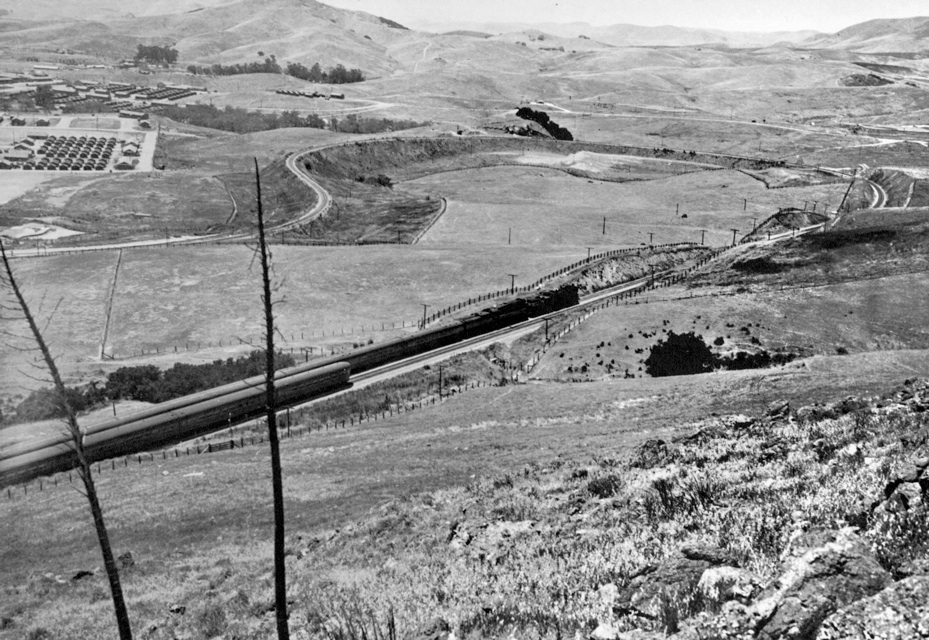
At this point, most of the passengers are enjoying lunch in the coffee shop and dining cars. The Cuesta Pass is also the midpoint of the trip and both Daylights would meet and pass each other just north of San Luis Obispo.
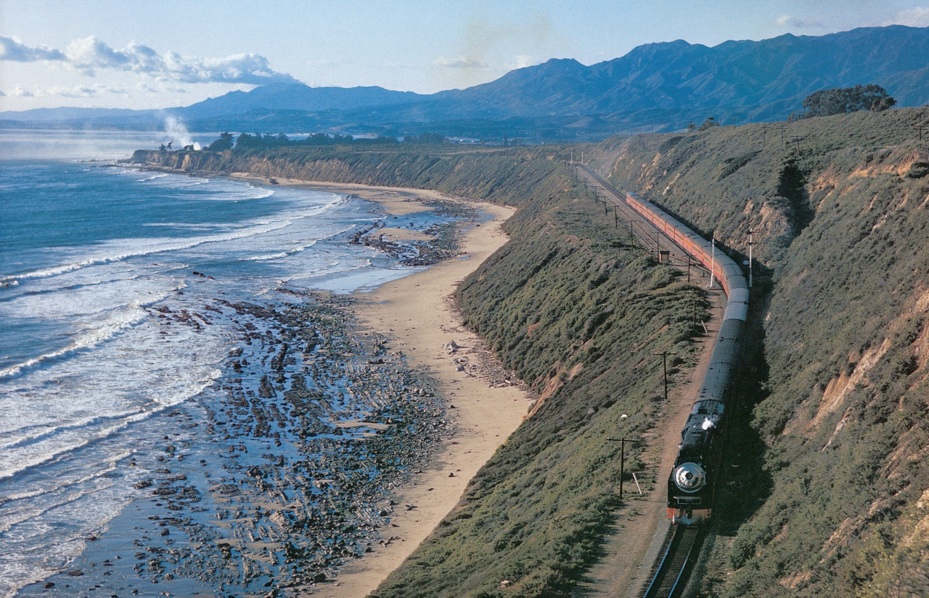
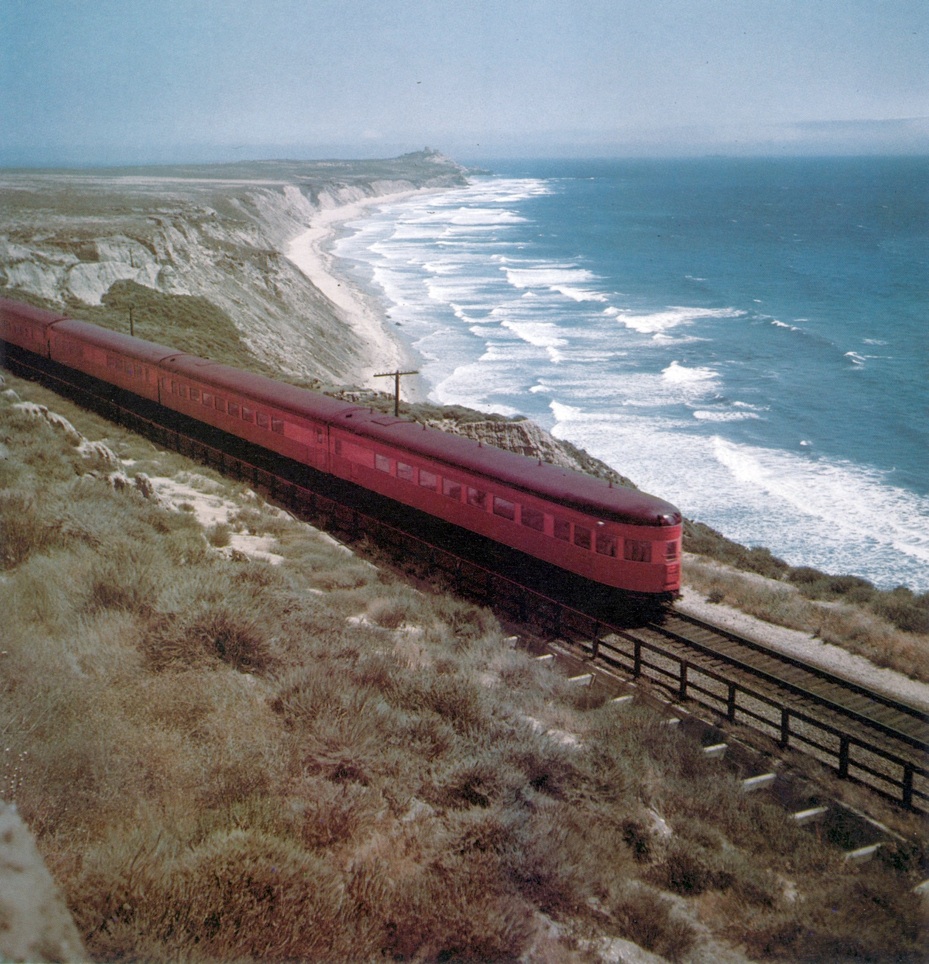

More famous were the 113 miles of ocean side trackage with fantastic views of the rolling hills, beach, and ocean. Passengers enjoyed the vast expanse of the Pacific Ocean from the comfort of their seat on the Daylight.
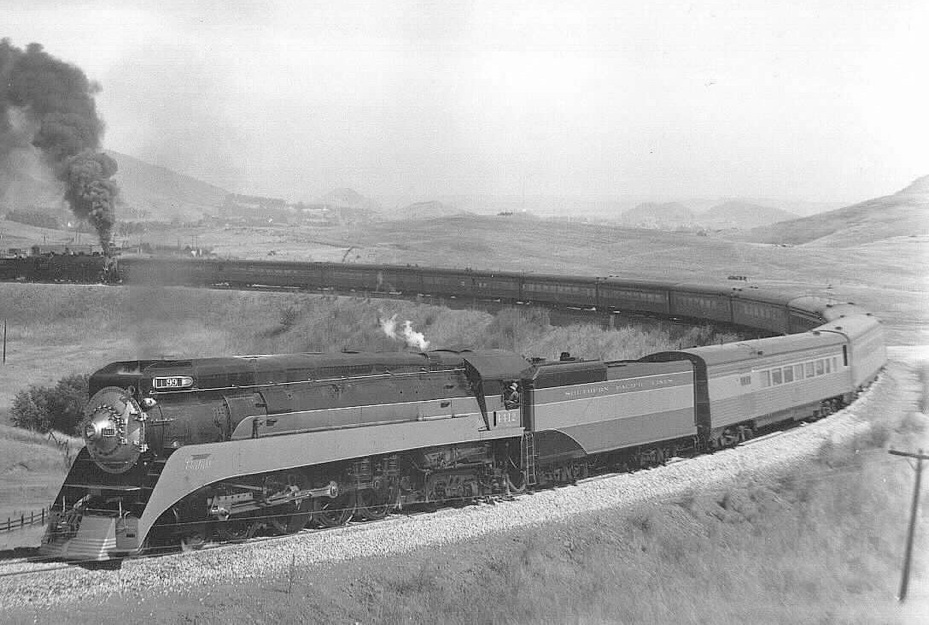
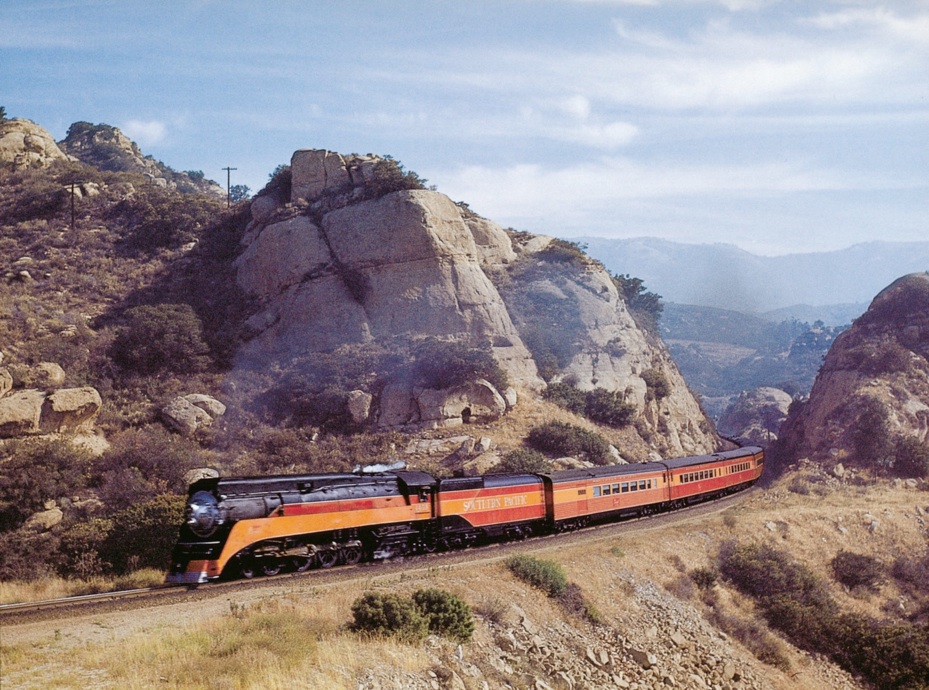
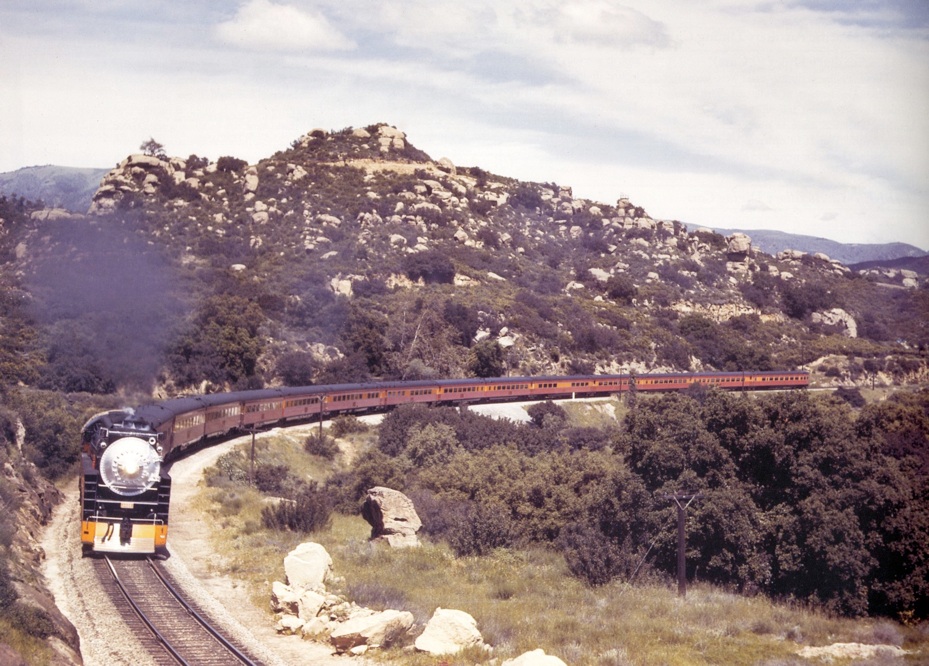
Besides the coast line, passengers enjoyed the scenery inland as well. These two color photos were taken in the area around Chatsworth and Simi Valley, California.
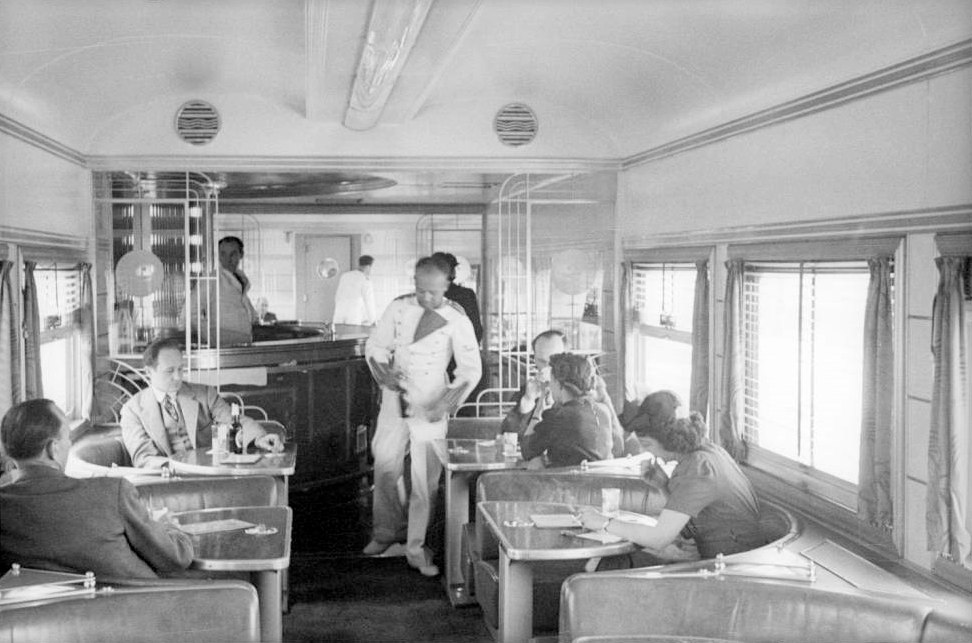
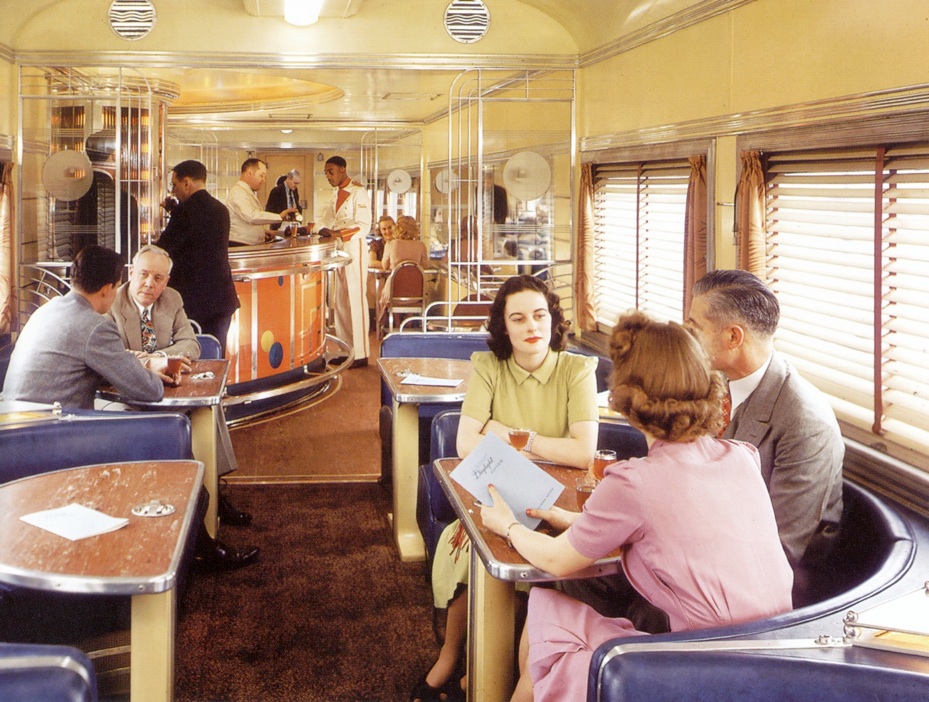
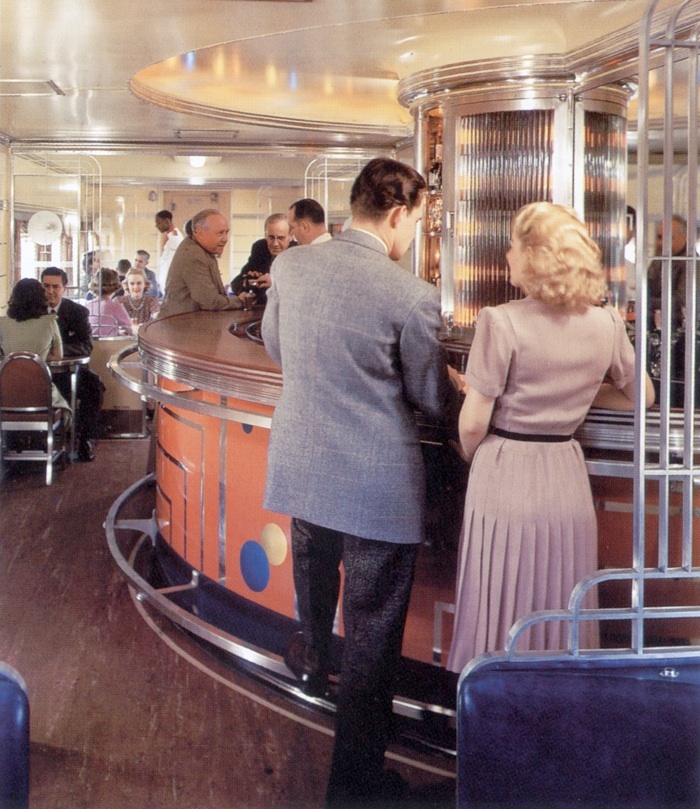
The black and white photo taken by a passenger and the two color photos taken by Southern Pacific for promotional purposes are of the Tavern car. When you needed a drink, the Tavern car was the place to go. With the blue Pacific Ocean filling the picture windows, a captive passenger audience of hundreds with time on their hands were dazzled by skilled mixologists creating exotic cocktails at 80 mph amid colored spectrum lights reflecting in the mirrors behind the bar. That was really something!


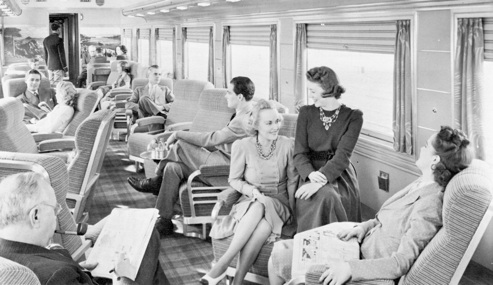
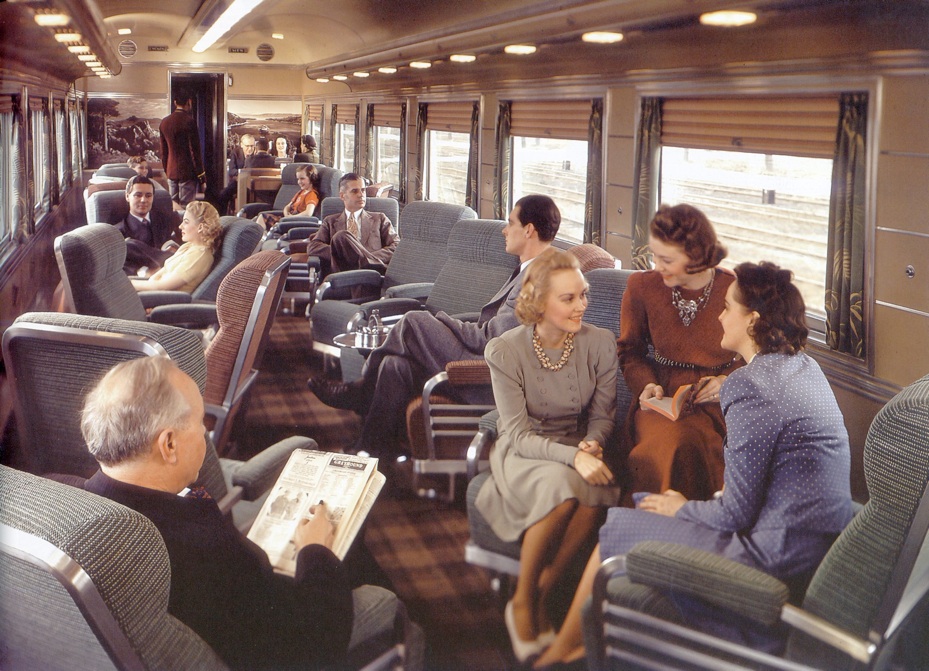
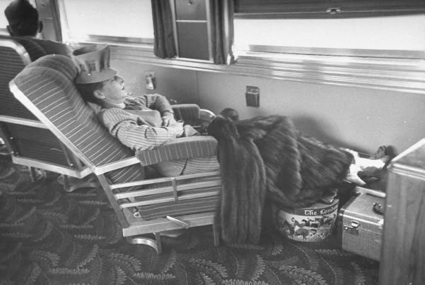

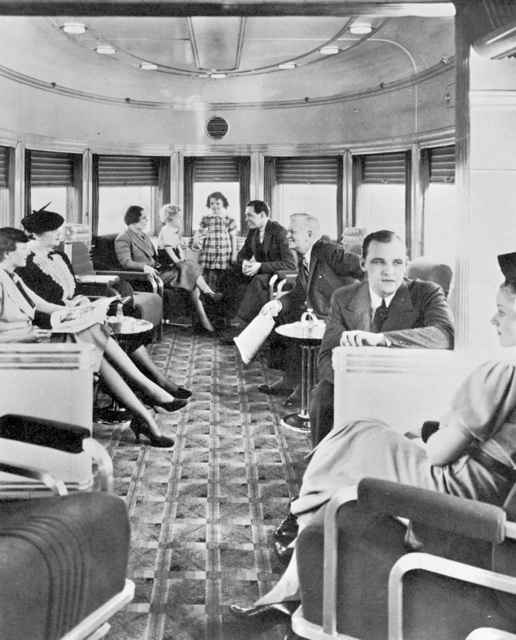
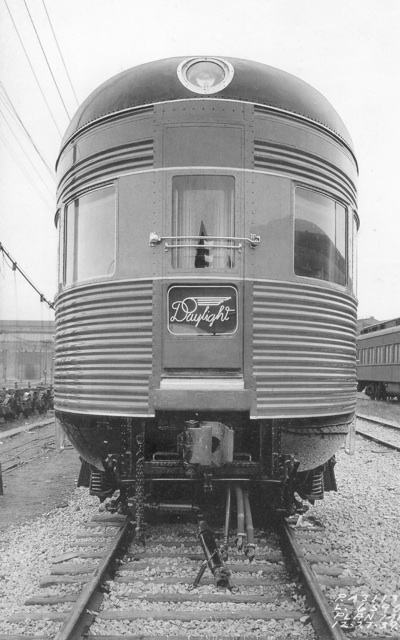
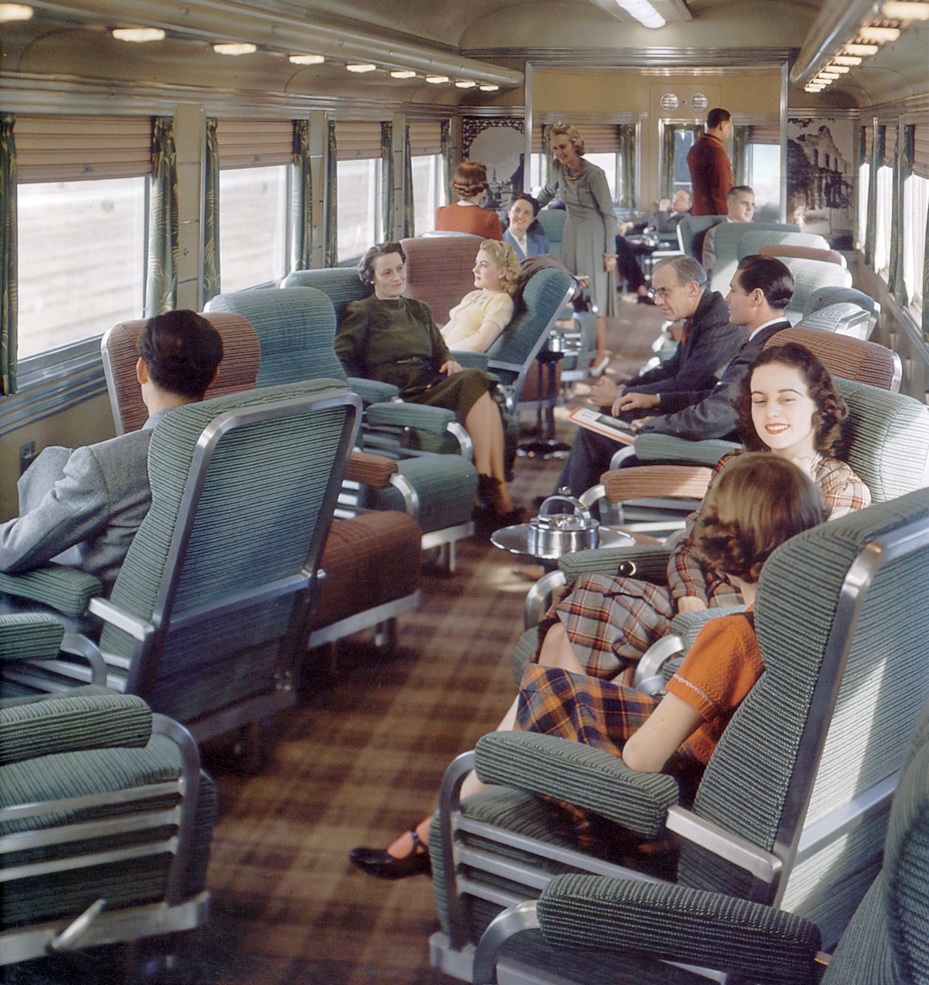
The Parlor and Parlor-Observation cars were located at the end of the train next to the Tavern car. These cars were for the first class passengers. The cars tended to give the feeling of good living, designed to reproduce the relaxed atmosphere of a luxurious hotel lobby, living room, or exclusive club. In both cars one could read, write on Daylight monogrammed stationery, play cards, or sight-see, particularly along the more than 100 miles of ocean vistas. Extra spacious and restful, the Parlor-Observation car's fantail room was available to all parlor car passengers. Seating 10, it contained two double and six single seat sofas arranged around the oval end, with its curving windowed panorama. Eight more passengers could be seated in two card sections at the forward end. There were also two tables with magazine racks and light stands, and two floor stand ashtrays. The seating section of the Parlor-Observation accommodated 23 passengers. Both cars were fitted with carpets, drapes, radio, and public address systems and porter call buttons. Home was never like this! Note the black and white photo, taken by a passenger and not SP, showing the coats hanging over the racks in the Parlor-Observation car ... maybe home was like this!

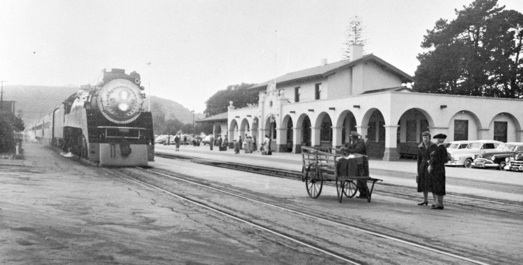

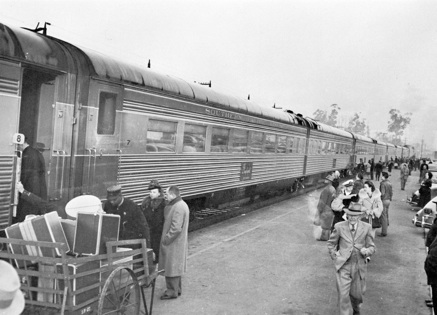
The Daylights would make brief stops along their 471 mile route at San Jose, Salinas, San Luis Obispo, Santa Barbara, and Glendale, for passengers to board or depart and for the engine to take on water as well as engine crews to quickly lube and oil the engine. With stops lasting 3-5 minutes, the Daylights were off quickly to continue their journeys.
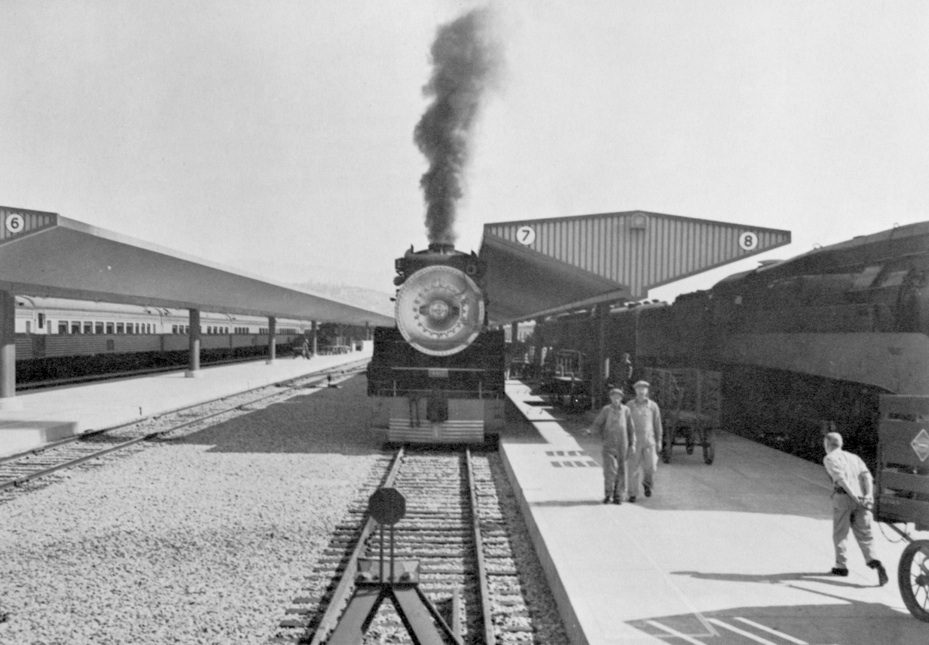
That evening at 6 p.m., the Daylights would arrive at their respective terminals, right on time, after 9 hours 45 minutes of travel time. The above photo shows the terminal at Los Angeles at the time. As a passenger your trip was over, however if you were a Southern Pacific maintenance worker, your job was just about to begin!
To keep the Daylights running smoothly, regular maintenance was crucial, and because of the Daylight's daytime operation, everything had to be done in the evening and at night. Dedicated teams formed to take care of the train, men skilled in steam heating, air-conditioning, electrical work (telephones, radios, generators, motors, and electrical refrigeration), brake equipment, and automatic train control. There were also coach cleaners, laborers, plumbers, upholsterers, car inspectors, painters, and commissary personnel.
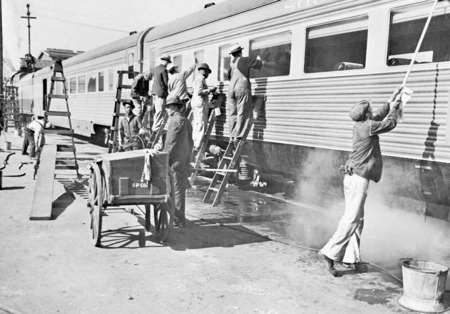
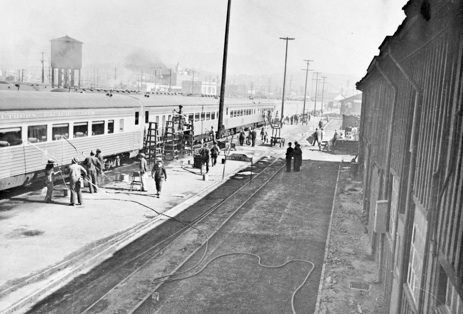
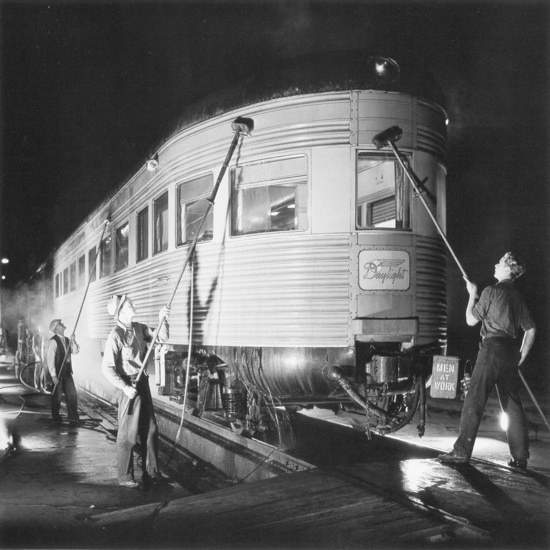
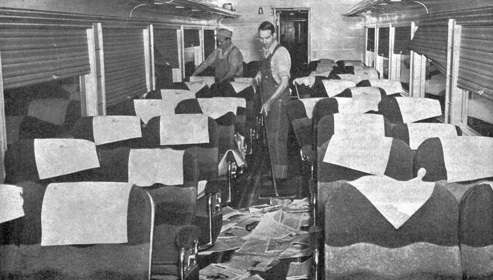
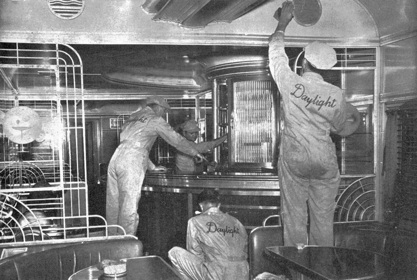
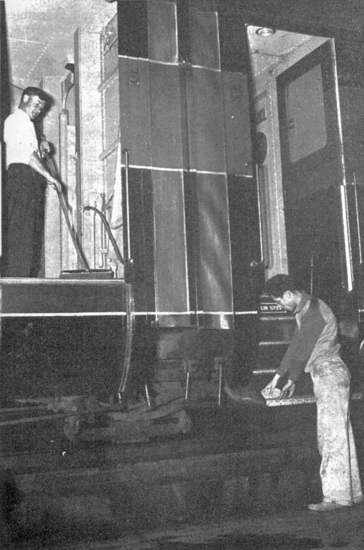
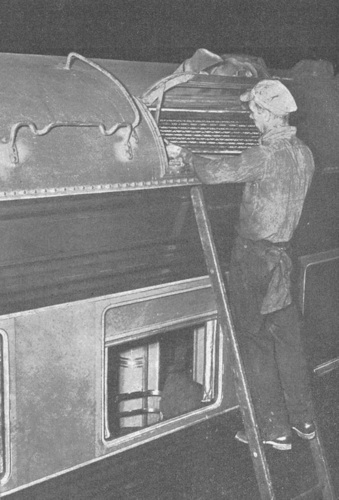
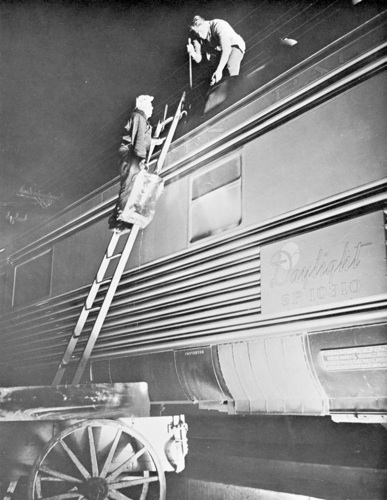
The passenger cars were washed using fountainhead brushes. Laborers swabbed the roofs and sides with soap and water, then rinsed them with clear water before wiping them dry with chamois. Trucks were steam cleaned daily and repainted every 10 to 12 days. The exterior was waxed every two weeks. Minor repainting was done to retouch lettering and surface scratches.
In the dining, tavern, and parlor cars, the workers vacuumed the carpets and seats every night. Periodically they removed carpets for beating and shampooing by means of high pressure air. They checked upholstery for spots or stains, cleaned and polished all furniture; swept, mopped, and waxed the linoleum floors and sanitized and restocked the toilets, kitchen, pantry, and bars. Surfaces of the double windows and trim were cleaned, then the ceilings, walls, and vestibules. In the Daylight's dining, coffee shop, and tavern cars, ceilings received a new coat of paint on a regular basis because of the heavy buildup of nicotine stains from smoking!
Special pits facilitated the removal of wheels, trucks, brake rigging, air brake systems, steam lines, appliances, and other heavy equipment. Empty propane gas cylinders and air intake filters were changed, batteries tested and serviced, generator belts replaced, water tanks replenished, containers iced. A single block of ice, hand carried up a ladder, weighed 100 pounds.
Working through the night, the Daylight trains were made ready for the next morning’s run. What was Train 98 the previous evening, became Train 99 to San Francisco, and Train 99 the previous evening became Train 98 to Los Angeles. Passengers arriving for their trip probably never thought how much work was done overnight to make the trains ready for their 471 mile ride!


